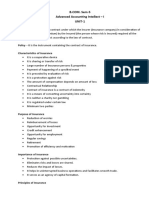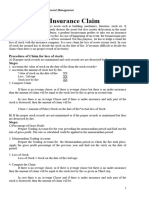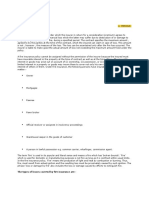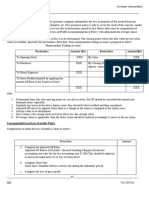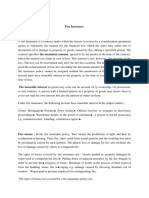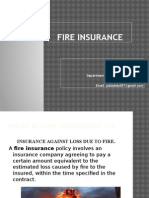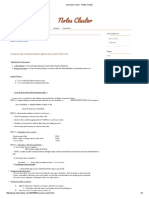0 ratings0% found this document useful (0 votes) 18 views4 pagesModule 5
This pdf contains notes of module 5
Copyright
© © All Rights Reserved
We take content rights seriously. If you suspect this is your content,
claim it here.
Available Formats
Download as PDF or read online on Scribd
e
CORPORATE ACCOUNTING I
MODULE V
INSURANCE CLAIMS
2 MARK QUESTIONS
What do you mean by insurance claim?
The claim lodged by the business to the insurance company on happening
the event of specific loss is called insurance claim.
What are the types of insurance claims?
Loss of assets including stock
Loss of profit as a consequent to fire
What do you mean by loss of stock policy?
‘When the fixed assets are lost by fire, there is a possibility to occur huge
loss for the business. Loss of stock policy is the policy for compensating
the loss arising due to the loss arising for fixed assets due to fire.
. What do you mean by loss of profit policy?
A loss of profit policy is a policy attached to the fire insurance policy,
where the insured will be compensated also for loss in profit due to
interruption in business activities due to fire in addition to loss of stock.
What is average clause?
When a business takes an insurance policy, the value of which is less than
the value of the average stock in the business, it is known as “Under
insurance”. Generally fire insurance policies contain an Average Clause
to discourage under-insurance. Average clause is a provision in the
insurance contract in which the insurance claim due on loss of stock is
reduced to the proportion that the policy value bears to the value of stock
on the date of fire.
6. What is indemnity period?
© scanned with OKEN Scanner�It is the period beginning with the occurrence of the damage and ending
not later than 12 months after the occurrence of damage.
7. What is annual sales?
It is the turn over during the twelve months immediately preceding the
date of damage of fire.
8. What is short sales?
Short sales is the shortage in sales during the indemnity period because of
dislocation in business due to fire. It is the difference between standard
sales and actual sales of dislocated (indemnity) period.
10.What is standard turn- over?
It is the turn over during that period in the twelve months immediately
before the date of damage which corresponds with the indemnity period.
11. What is insured standing charges?
The insured standing charges are those standing charges specified in the
policy which the insured desires to recover in the case of an accident.
12. What is memorandum Trading Account?
Memorandum Trading Account is an account prepared to find out the value
of stock of goods as on the date of fire as the balancing figure of the account.
Gross profit may be ascertained on the basis of the percentage of gross profits
on sales and the balance in the account will be the value of stock as on the date
of fire.
5 MARK QUESTIONS
1. What is memorandum trading account? Why it is prepared?
Memorandum Trading Account is an account prepared to find out the
value of stock of goods as on the date of fire as the balancing figure of the
account. Gross profit may be ascertained on the basis of the percentage of
© scanned with OKEN Scanner�gross profits on sales and the balance in the account will be the value of
stock as on the date of fire.
Memorandum Trading Account
Particulars Rs. Particulars Rs.
To Opening Stock XXX By Sales XXX
To Purchases XXX Less : Return XXX XXX
Less: Return XXX XXX By Closing Stock XXX
To Carriage inwards XXX
To Wages XXX
To Direct expenses XXX
To Gross Profit (% on sales) XXX,
XXxx XXXX
2. What is average clause? Explain with an example.
When a business takes an insurance policy, the value of which is less than
the value of the average stock in the business, it is known as “Under
insurance”. Generally fire insurance policies contain an Average Clause
to discourage under-insurance. Average clause is a provision in the
insurance contract in which the insurance claim due on loss of stock is
reduced to the proportion that the policy value bears to the value of stock
on the date of fire.
X took out a fire insurance policy containing an average clause covering
his stock for Rs.40,000. On the date of fire the value of stock was
Rs.50,000. The loss was assessed at Rs.30,000.
In this case, the value of stock on the date of fire was more than the
policy value. Therefore, the average clause is applicable. X can recover
from the insurance company.
© scanned with OKEN Scanner�3.
Claims to be lodged = Loss of Stock x Policy Value
Value of stock on the date of fire
Explain the various steps in ascertaining the loss of stock by fire.
a. Ascertaining the value of stock at the time of fire
The value of stock can be ascertained by preparing a memorandum
trading account for the period. Memorandum Trading Account is an
account prepared to find out the value of stock of goods as on the date of
fire as the balancing figure of the account. Gross profit may be
ascertained on the basis of the percentage of gross profit on sales and the
balance in the account will be the value of stock on the date of fire.
b. Ascertainment of net loss of stock after deducting the salvage
value of stock
Salvage value if any, has to be deducted from the estimated value of stock
on the date of fire for getting net loss.
c. Application of average clause
When a business takes an insurance policy, the value of which is less than
the value of the average stock in the business, it is known as “Under
insurance”. Generally fire insurance policies contain an Average Clause
to discourage under-insurance. Average clause is a provision in the
insurance contract in which the insurance claim due on loss of stock is
reduced to the proportion that the policy value bears to the value of stock
on the date of fire.
© scanned with OKEN Scanner








